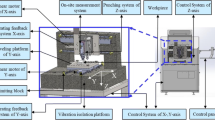Abstract
While the indentation method is an excellent way to evaluate the mechanical properties of various sizes of materials, from the nano-scale to the macro-scale, its applications have been limited to measuring mechanical properties. In this study we propose a new application of the dynamic indentation method, in an indentation machining technology for mass-production. The core idea is that the array of residual indentations generated by dynamic indentation testing can be used to fabricate a lens array suitable for thinner and brighter displays. We developed an advanced system from a dynamic indentation system, whose maximum speed and maximum specimen size were about 10Hz and 250 mm*250 mm, respectively. Using dual actuating heads this system was used to produce arrays of lenses having depths of 1 μm to 6 mm. Pile-up is a critical reason why indentation machining technology had been not widely used in display industries. Since lower pile-up is observed in more ductile copper-based metals, we increased the annealing time of the metal molds to reduce the amount of pile-up. Then, following a quantitative analysis of the annealing heat treatment and resulting amount of pile-up, a lens array was successfully machined on a metal mold fabricated by the developed system. The machined metal mold was used to manufacture optical plates for a lens array. The results verified that the indentation machining technology proposed in this study, based on the dynamic indentation method, can be applied for the manufacturing of optical components for better displays.













Similar content being viewed by others
References
Oliver WC, Pharr GM (1992) An improved technique for determining hardness and elastic modulus using load and displacement sensing indentation experiments. J Mater Res 7:1564–1583
Doerner MF, Gardner DS, Nix WD (1986) Plastic properties of thin films on substrates as measured by submicron indentation hardness and substrate curvature techniques. J Mater Res 1:845–851
Kucharski S, Jarząbek D, Piątkowska A, Woźniacka S (2015) Decrease of nano-hardness at ultra-low indentation depths in copper single crystal. Exp Mech. doi:10.1007/s11340-015-0105-2
Jeon Ec, Kim JY, Baik MK, Kim SH, Park JS, Kwon D (2006) Optimum definition of true strain beneath a spherical indenter for deriving indentation flow curves. Mater Sci Eng A 419:196–201
Herbert EG, Pharr GM, Oliver WC, Lucas BN, Hay JL (2001) On the measurement of stress-strain curves by spherical indentation. Thin Solid Films 398–399:331–335
Anstis GR, Chantikul P, Lawn BR, Marshall DB (1981) A critical evaluation of indentation techniques for measuring fracture toughness: I, direct crack measurement. J Am Ceram Soc 64:533–538
Lee JS, Jang JI, Lee BW, Choi Y, Lee SG, Kwon D (2006) An instrumented indentation technique for estimating fracture toughness of ductile materials: A critical indentation energy model based on continuum damage mechanics. Acta Mater 54:1101–1109
Swadener JG, Taljat B, Pharr GM (2001) Measurement of residual stress by load and depth sensing indentation with spherical indenter. J Mater Res 16:2091–2102
Lee YH, Kwon D (2003) Estimation of biaxial surface stress by instrumented indentation with sharp indenters. Acta Mater 52:1555–1563
Hay J, Agee P, Herbert E (2010) Continuous stiffness measurement during instrumented indentation testing. Exp Tech 34:86–94
White CC, VanLandingham MR, Drzal PL, Chang NK, Chang SH (2005) Viscoelastic characterization of polymer using instrumented indentation. II. Dynamic testing. J Polym Sci B 13:1812–1824
Balooch G, Marshall GW, Marshall SJ, Warren OL, Asif SAS, Balooch M (2003) Evaluation of a new modulus mapping technique to investigate microstructural features of human teeth. J Biomech 37:1223–1232
Yan J, Horihoshi A, Kuriyagawa T, Fukushima Y (2012) Manufacturing structured surface by combining microindentation and ultraprecision cutting. CIRP J Manuf Sci Technol 5:41–47
Möller S, Forrest SR (2002) Improved light out-coupling in organic light emitting diodes employing ordered microlens array. J Appl Phys 91:3324–3327
Lin HY, Ho YH, Lee JH, Chen KY, Fang JH, Hsu SC, Wei MK, Lin HY, Tsai JH, Wu TC (2008) Patterned microlens array for efficiency improvement of small-pixelated organic light-emitting devices. Opt Express 16:11044–11051
Chaudhri MM, Winter M (1988) The load-bearing area of a hardness indentation. J Phys D Appl Phys 21:370–374
McElhaney KW, Vlassak JJ, Nix WD (1998) Determination of indenter tip geometry and indentation contact area for depth-sensing indentation experiments. J Mater Res 13:1300–1306
Oliver WC, Pharr GM (2004) Measurement of hardness and elastic modulus by instrumented indentation: Advances in understanding and refinements to methodology. J Mater Res 19:3–20
Cheng YT, Cheng CM (1998) Effects of ‘sinking in’ and ‘piling up’ on estimating the contact area under load in indentation. Philos Mag Lett 78:115–120
Dieter GE (1988) Mechanical metallurgy. McGraw Hill, London
Lim YY, Chaudhri MM (1999) The effect of the indenter load on the nanohardness of ductile metals: an experimental study on polycrystalline work-hardened and annealed oxygen-free copper. Philos Mag A 79:2979–3000
Davis JR (2001) Copper and copper alloys. ASM International, Novelty
ISO/TR 29381:2008 (2008) Metallic materials - Measurement of mechanical properties by an instrumented indentation test - Indentation tensile properties. ISO, Geneva
Lee JR, Jeon Ec, Kim H, Woo SW, Je TJ, Yoo YE, Lee ES (2015) Optical characterization and manufacturing of an optical plate for increasing light efficiency of LED systems. Int J Precis Eng Manuf 16:1355–1360
Acknowledgments
This research was partly supported by ‘Development of Convergence Manufacturing Technology for Functional Nanostructures of Active Devices’ funded by the ‘National Research Council of Science & Technology’ and partly supported by the ‘Center for Advanced Meta-Materials(CAMM)’ funded by the ‘Ministry of Science, ICT and Future Planning’ as ‘Global Frontier Project (CAMM-2014M3A6B3063707)’.
Author information
Authors and Affiliations
Corresponding author
Rights and permissions
About this article
Cite this article
Jeon, Ec., Lee, JR., Choi, DH. et al. A New Application of Dynamic Indentation: Indentation Machining Technology. Exp Mech 57, 1127–1133 (2017). https://doi.org/10.1007/s11340-016-0187-5
Received:
Accepted:
Published:
Issue Date:
DOI: https://doi.org/10.1007/s11340-016-0187-5




